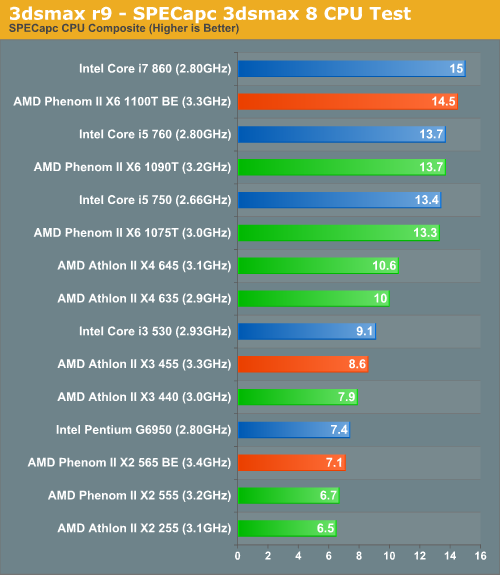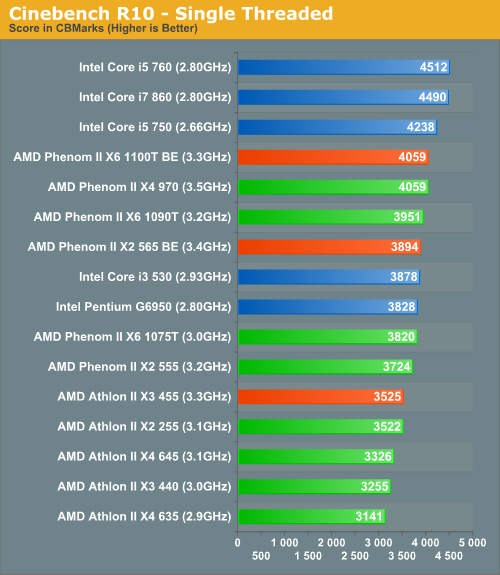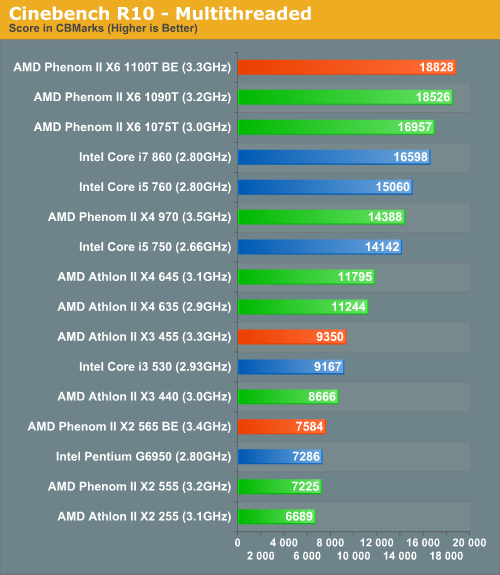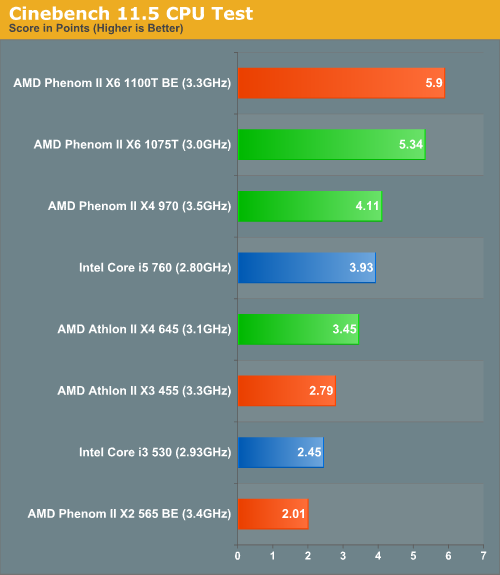AMD's Winter Update: Athlon II X3 455, Phenom II X2 565 and Phenom II X6 1100T
by Anand Lal Shimpi on December 7, 2010 12:01 AM EST- Posted in
- CPUs
- AMD
- Phenom II X6
- Athlon II
- Phenom II
3dsmax 9 - SPECapc 3dsmax CPU Rendering Test
Today's desktop processors are more than fast enough to do professional level 3D rendering at home. To look at performance under 3dsmax we ran the SPECapc 3dsmax 8 benchmark (only the CPU rendering tests) under 3dsmax 9 SP1. The results reported are the rendering composite scores.

This is the closest we've ever seen the Phenom II X6 to Intel's Core i7 series. Here the 860 is a bit faster but it's also more expensive, the 1100T is a good fit here. The Athlon II X3 455 is 16% faster than its closest competitor, while the Phenom II X2 565 BE falls behind its target. This is very similar to what we reported a couple of months ago, the Athlon II X3 is a great value while the Phenom II X2 makes sense only if you can unlock at least one of its cores.
Cinebench R10
Created by the Cinema 4D folks we have Cinebench, a popular 3D rendering benchmark that gives us both single and multi-threaded 3D rendering results.

Single threaded performance is an advantage the i5/i7s have over the Phenom II X6s, however thanks to the high turbo core speed of the 1100T the gap isn't huge. The Athlon II X3 trails the G6950 here as its core advantage is useless in a single threaded application.

Turn up the threads and there's no beating the Phenom II X6 and Athlon II X3, they both do much better than their intended competition.
I've started running Cinebench 11.5 in preparation for an update to Bench, some of the initial results are below:

The Phenom II X6 1100T and Athlon II X3 do very well once again.










65 Comments
View All Comments
Aone - Tuesday, December 7, 2010 - link
Unfortunately, the auther didn't explain the big and strange difference between the idle power figures of Athlons and Phenoms.For instance:
Athlon II X3 455 (3.3GHz) - 63.9W,
Athlon II X3 440 (3.0GHz) - 80.3W!
Phenom II X4 970 (3.5GHz) - 66.9,
Athlon II X4 645 (3.1GHz) - 75W!
Athlon II X4 635 (2.9GHz) - 79.5W!
shooty - Tuesday, December 7, 2010 - link
I am also interested in this difference... specifically the x2 555 vs the x2 565.Almost a 20W difference in idle and a 40W difference at load!
What is going on to give this huge difference for (just) a clock bump?
Anand, can you please post tested voltages of these cpus? I know from my experience that some motherboards put them at a higher stated voltage (above 1.4v).
BTW, I'm 2 for 2 in getting the two extra cores to be stable on the 555.
Marlin1975 - Tuesday, December 7, 2010 - link
not only that but the lowwer Ghz chip was beating the higher Ghz chip in games.Maybe there is more than just a speed bump?
Anand Lal Shimpi - Tuesday, December 7, 2010 - link
As I mentioned in the test page our older Athlon II/Phenom II numbers were run on a 7-series board vs. the new 890GX board we switched to in the last review. I've pulled the conflicting numbers to avoid confusion :)Take care,
Anand
semo - Tuesday, December 7, 2010 - link
I'm pretty sure the X2 chip offers directed I/O and possibly better vm performance than the X3. It would be interesting to find out.Also I don't like it when the front page introduction differs from the main article's. I think you should keep it consistent across all front page articles (news or reviews).
StevoLincolnite - Tuesday, December 7, 2010 - link
I have a Phenom 2 x6 1090T.Now I'm wondering why you didn't push more voltage through that chip? It can handle 1.45volts with a decent cooler easily enough which would have pushed you over that 4ghz mark.
I'm also surprised at the large performance difference the 100mhz increase in clockspeed provided in the benchmarks between the 1090T and the 1100T!
108fps for the 1090T and 120fps for the 1100T.
That's what... 10-12% improvement for just 100mhz? Doesn't seem to add-up in my eyes.
Finally - Tuesday, December 7, 2010 - link
Just because your chip can handle 1.45V, doesn't mean that any chip can.nitrousoxide - Tuesday, December 7, 2010 - link
Thubans can reach 4.0GHz at 1.4V, that's true for almost all the Thuban parts.MrSpadge - Tuesday, December 7, 2010 - link
The board has changed. Such things matter in games.MrS
chester457 - Tuesday, December 7, 2010 - link
I use 7zip everyday and find your 7zip benchmark a little misleading. I'd prefer if you just did a bench with only 2 cores enabled. PAR2 already tests 3+ core archiving. By using 7zip you're invoking real-world performance because 7zip is a program many people use daily. It'd be nice to have the 2 core (real-world) performance instead of a theoretical one no user can ever hit.